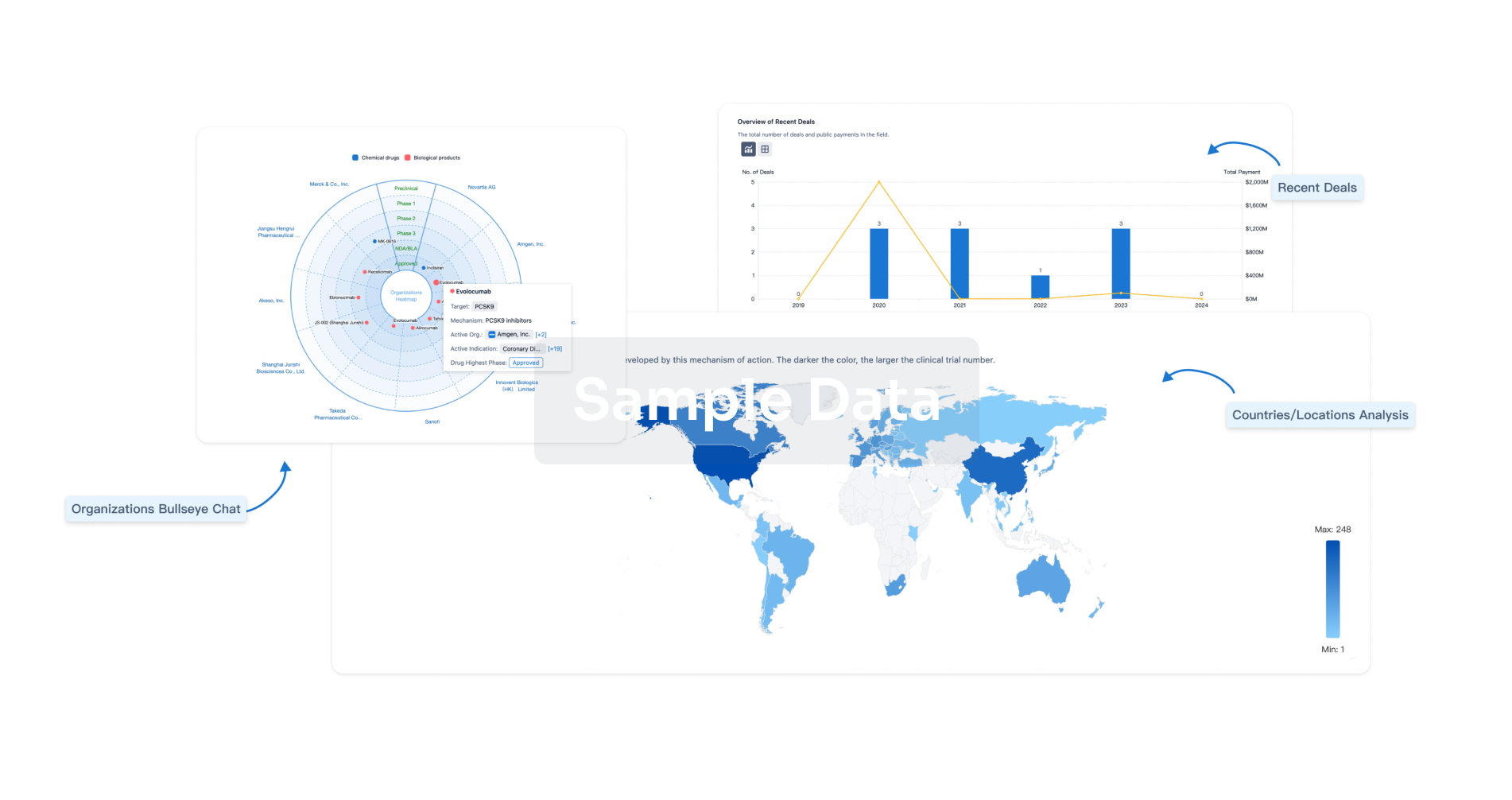Request Demo
Last update 08 May 2025
FLT3 x NTRK x AXL
Last update 08 May 2025
Related
2
Drugs associated with FLT3 x NTRK x AXLMechanism AXL inhibitors [+5] |
Active Org. |
Originator Org. |
Active Indication |
Inactive Indication- |
Drug Highest PhasePhase 1 |
First Approval Ctry. / Loc.- |
First Approval Date20 Jan 1800 |
Target |
Mechanism AXL inhibitors [+2] |
Active Org. |
Originator Org.- |
Active Indication |
Inactive Indication |
Drug Highest PhasePreclinical |
First Approval Ctry. / Loc.- |
First Approval Date20 Jan 1800 |
5
Clinical Trials associated with FLT3 x NTRK x AXLCTR20220834
评估TSN084片治疗晚期恶性肿瘤受试者的安全性、耐受性、药代动力学、药效动力学特征及初步疗效的开放、多中心、Ia/Ib期研究
[Translation] An open, multicenter, Phase Ia/Ib study to evaluate the safety, tolerability, pharmacokinetic, pharmacodynamic characteristics, and preliminary efficacy of TSN084 tablets in the treatment of subjects with advanced malignant tumors
主要研究目的:评估TSN084片在晚期或转移性恶性肿瘤受试者中的安全性、耐受性、剂量限制性毒性(DLTs)和初步抗肿瘤活性,确定最大耐受剂量(MTD)、扩展期推荐剂量(RDE)和II期临床研究推荐剂量。次要研究目的:评估TSN084片药代动力学(PK)特征和初步抗肿瘤活性。探索性研究目的:探索TSN084的暴露量/剂量与安全性以及临床疗效之间的关系以及生物标志物。
[Translation]
The main purpose of the study is to evaluate the safety, tolerability, dose-limiting toxicities (DLTs) and preliminary anti-tumor activity of TSN084 tablets in subjects with advanced or metastatic malignancies, and to determine the maximum tolerated dose (MTD), recommended dose for extension (RDE) and recommended dose for Phase II clinical studies. The secondary purpose of the study is to evaluate the pharmacokinetic (PK) characteristics and preliminary anti-tumor activity of TSN084 tablets. The purpose of the exploratory study is to explore the relationship between the exposure/dose of TSN084 and safety and clinical efficacy, as well as biomarkers.
Start Date20 Jul 2022 |
Sponsor / Collaborator |
NCT06386705
A Multicenter, Open-label, Phase Ia/Ib Study to Evaluate the Safety, Tolerability, Pharmacokinetics, Pharmacodynamics, and Preliminary Efficacy of TSN084 Tablets in Patients With Advanced Malignant Tumors.
TSN084 is a novel type II kinase inhibitor with demonstrated anti-tumor effects in vitro and in vivo and targets multiple tyrosine kinases, such as c-MET, FLT3, TRK and serine/threonine kinase CDK8/19. This phase 1a/1b study is conducted to assess the maximum tolerated dose (MTD) and dose-limiting toxicity (DLT), to evaluate the pharmacokinetics, safety and preliminary anti-tumor activity of TSN084 in advanced or metastatic malignancies in China.
Start Date20 Jul 2022 |
Sponsor / Collaborator |
NCT05300438
A Multicenter, Open-label, Phase Ia/Ib Study to Evaluate the Safety, Tolerability, Pharmacokinetics, Pharmacodynamics, and Preliminary Efficacy of TSN084 Tablets in Patients With Advanced Malignant Tumors.
TSN084 is a novel type II protein kinase inhibitor with demonstrated anti-tumor effects in vitro and in vivo and targets multiple tyrosine kinases, such as c-MET, FLT3, TRK and serine/threonine kinase CDK8/19. This first-in-human study is conducted to assess the maximum tolerated dose (MTD) and dose-limiting toxicity (DLT), to evaluate the pharmacokinetics, safety and preliminary anti-tumor activity of TSN084 in advanced or metastatic malignancies.
Start Date18 Feb 2022 |
Sponsor / Collaborator |
100 Clinical Results associated with FLT3 x NTRK x AXL
Login to view more data
100 Translational Medicine associated with FLT3 x NTRK x AXL
Login to view more data
0 Patents (Medical) associated with FLT3 x NTRK x AXL
Login to view more data
5
Literatures (Medical) associated with FLT3 x NTRK x AXL01 Oct 2019·HaematologicaQ1 · MEDICINE
Hematopoietic niche drives FLT3-ITD acute myeloid leukemia resistance to quizartinib via STAT5-and hypoxia-dependent upregulation of AXL
Q1 · MEDICINE
Article
Author: Artus, Alexandre ; Izac, Brigitte ; Pasquet, Jean-Max ; Kosmider, Olivier ; Desplat, Vanessa ; Praloran, Vincent ; Villacreces, Arnaud ; Vigon, Isabelle ; Mansier, Olivier ; Guitart, Amélie ; Dufossée, Mélody ; Dubus, Pierre ; Dumas, Pierre-Yves ; Bidet, Audrey ; Dusanter-Fourt, Isabelle ; Giese, Alban ; Pigneux, Arnaud ; Casetti, Luana ; Martin-Lannerée, Séverine ; Rousseau, Benoît ; Naudin, Cécile ; Milpied, Noël
01 Aug 2016·Cell Biology and Toxicology
CBT profiles of cabozantinib approved for advanced renal cell carcinomas
Communications
Author: Wang, Xiangdong
BiomedicinesQ3 · ENGINEERING & TECHNOLOGY
Selective Inhibition of HDAC Class I Sensitizes Leukemia and Neuroblastoma Cells to Anticancer Drugs
Q3 · ENGINEERING & TECHNOLOGY
ArticleOA
Author: Leonova, Olga ; Kozlov, Maxim ; Kochetkov, Sergey ; Spirin, Pavel ; Popenko, Vladimir ; Vagapova, Elmira ; Prassolov, Vladimir ; Lebedev, Timofey ; Ivanenko, Karina
Analysis
Perform a panoramic analysis of this field.
login
or

AI Agents Built for Biopharma Breakthroughs
Accelerate discovery. Empower decisions. Transform outcomes.
Get started for free today!
Accelerate Strategic R&D decision making with Synapse, PatSnap’s AI-powered Connected Innovation Intelligence Platform Built for Life Sciences Professionals.
Start your data trial now!
Synapse data is also accessible to external entities via APIs or data packages. Empower better decisions with the latest in pharmaceutical intelligence.
Bio
Bio Sequences Search & Analysis
Sign up for free
Chemical
Chemical Structures Search & Analysis
Sign up for free

